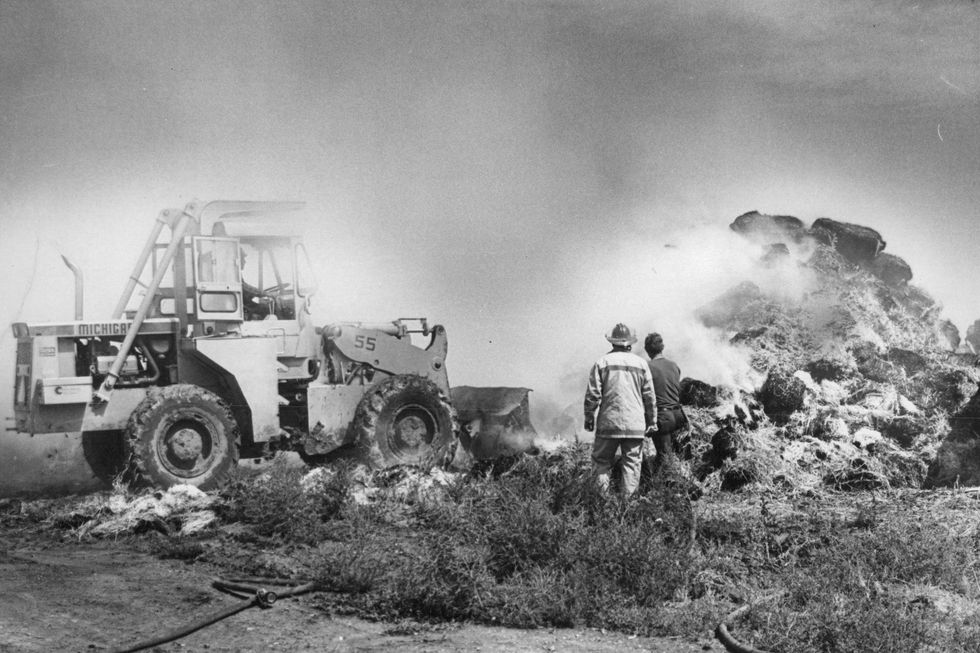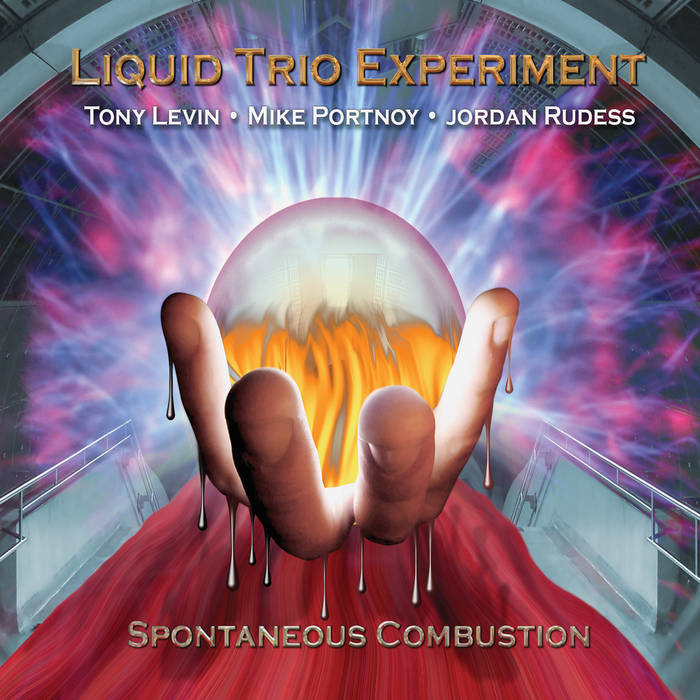Spontaneous combustion might be real, and pigs might help us figure out why it happens

First things first - yes, it turns out that spontaneous combustion of humans might actually be a real thing. I know what you're thinking: no, it's not. It's just a fire no one caught, or something sparking, or some other very logical and reasonable explanation. And trust me, I'm with you. Or at least I was. But it turns out that, maybe, just maybe, it's a real thing.
Last year, a man in Ireland was found near the furnace of his apartment. But the coroners determined that the furnace was not the source of the fire. There were burn marks on the floor and ceiling directly above and below the body, but no where else in the apartment. And, io9 says that the only case of spontaneous combustion that has a witness comes from a father taking care of his mentally disabled daughter. They write :
One day he saw a flash out of the corner of his eye, and turned to find her on fire. Despite the flames, she continued to quietly sit in a chair, not reacting and not giving any indication she was in pain. The man's attempts to put the fire out left him with burned hands. The woman lived through the combustion, but slipped into a coma and died shortly afterwards. This indicates one of the strangest parts of human combustion. It takes a very hot flame to reduce a human body to ash. Crematoriums have special chambers designed for it. However, in almost all combustions, there's no burns in the room around the body, indicating that the person simply stayed in one place. Whatever the cause of this combustion, it seems to knock people out first.
New Scientist has a whole feature describing the science behind why humans spontaneously combust. They write:
People explode. One minute they may be relaxing in a chair, the next they erupt into a fireball. Jets of blue fire shoot from their bodies like flames from a blowtorch, and within half an hour they are reduced to a pile of ash. Typically, the legs remain unscathed, sticking out grotesquely from the smoking cinders. Nearby objects (a pile of newspapers on the armrest, for example) are untouched. Greasy fat lies on the floor. For centuries, this gruesome way of death has been debated, with many people discounting it as a myth. But spontaneous human combustion is real and we think we can show how it happens.
Now, that feature was written by a man named Brian J. Ford. He's a biologist who researches spontaneous combustion. So, of course, he thinks it's real. And he's trying to figure out why it happens. Here's a video of Ford explaining his latest experiment. It involves blowing up a pig. Ford is using these pigs as human proxies. The idea is that humans build up too much acetone in their bodies, which can ignite. New Scientist :
In this video, two miniature dummies burn in about 30 minutes until only their protruding legs are left, a classic hallmark often observed in human victims. Ford thinks the limbs remain unscathed because they contain less fat and so can't absorb as much acetone.
If you'd rather read, than watch, here's Ford explaining:
I felt it was time to test the realities, so we marinated pork abdominal tissue in ethanol for a week. Even when cloaked in gauze moistened with alcohol, it would not burn. Alcohol is not normally present in our tissues, but there is one flammable constituent of the body that can greatly increase in concentration. Triacylglycerol lipids cleave to form fatty acid chains and glycerol. The fatty acids can be used as an alternative source of energy through beta-oxidation, giving rise to the key metabolic molecule acetyl-CoA. This helps drive the energy-producing Krebs cycle within the mitochondria of cells.
If Ford can prove that these pigs ignite when they've got too much acetone, he'll be one of the first people to suggest a probable, and experimentally validated explanation for the infamous phenomenon.
Source: io9 , New Scientist
Image: Montagious
This post was originally published on Smartplanet.com

One of the best tablets I've tested for watching movies is not an iPad or Samsung Galaxy
The windows laptop i recommend to most people undercuts the macbook air (but is just as capable), my favorite garmin sports watch ever just got a new version, and it costs $200 less.
Advertisement
Big burn theory: Why humans spontaneously combust
Spontaneous human combustion is a macabre phenomenon people either dismiss as a myth or blame on alcoholism. Brian J. Ford thinks he's found the real answer
By Brian J. Ford
15 August 2012

After the fire: the human remains after spontaneous combustion are very distinctive
(Image: Soren Hald/Getty Images)
PEOPLE explode. One minute they may be relaxing in a chair, the next they erupt into a fireball. Jets of blue fire shoot from their bodies like flames from a blowtorch, and within half an hour they are reduced to a pile of ash. Typically, the legs remain unscathed, sticking out grotesquely from the smoking cinders. Nearby objects (a pile of newspapers on the armrest, for example) are untouched. Greasy fat lies on the floor. For…
Sign up to our weekly newsletter
Receive a weekly dose of discovery in your inbox! We'll also keep you up to date with New Scientist events and special offers.
To continue reading, subscribe today with our introductory offers
No commitment, cancel anytime*
Offer ends 15 December 2024.
*Cancel anytime within 14 days of payment to receive a refund on unserved issues.
Inclusive of applicable taxes (VAT)
Existing subscribers
More from New Scientist
Explore the latest news, articles and features

New Scientist recommends Karl Ove Knausgaard's novel The Third Realm
Subscriber-only

The complicated role loneliness plays in 26 common health conditions

Why taking our grief out into nature can help us heal

Some brain injury patients would recover if life support weren't ended
Popular articles.
Trending New Scientist articles
Casual Ignition: The Sudden Science of Spontaneous Combustion
Turns out, what we consider “spontaneous” is a far cry from how scientists use the term.

Gear-obsessed editors choose every product we review. We may earn commission if you buy from a link. Why Trust Us?
- Spontaneous combustion is a chemical reaction , plain and simple.
- The core reaction is oxidation, when materials degrade while exposed to oxygen.
- The reaction releases heat , and sometimes that heat is trapped until it can ignite.
Last month, a barn near rural Jackson, Michigan, caught fire in a suspected spontaneous combustion . The culprit is wet hay, which is counterintuitive if you don’t know much about the underlying science; turns out, there are many ways for materials like hay to spontaneously combust. That set our curiosity ablaze: what is combustion, anyway? How is it different from ignition , which can also be spontaneous? And what about . . . human spontaneous combustion?
First, a quick note on terminology. In the vernacular sense, we use the word “spontaneous” to mean “sudden” or “spur of the moment.” That’s close to—but not exactly —what scientists mean when they call things spontaneous.
“‘Spontaneous’ is used to describe events or conditions that arise without the action of an external influence,” Tom Cleary , a chemical engineer in the Fire Research Division at the National Institute of Standards and Technology, tells Popular Mechanics . “Spontaneous combustion requires no external ignition source, spontaneous gene mutation has no identified external cause, and spontaneous fission, as in radioactive decay of an atom, takes place randomly with no external stimulus.”
Cleary mentions an external ignition source, and that brings up an important distinction: what makes combustion different from ignition? “[Ignition] is an energy source like a spark, flame or other high-temperature object or event that provides the initial local energy to start combustion of a fuel source,” he explains.
⚠️ Check your paper towels, because some mixed-composure ones can catch fire in the microwave due to microscopic metal content.
That idea of initial local energy is important. If you put a piece of regular paper in your oven at a high enough temperature, it will catch fire on its own without anyone lighting a match. If you do strike a match, the temperature can reach 1,500 degrees Fahrenheit, but we know from Ray Bradbury that paper burns at just 451 degrees—the temperature at which many people are roasting vegetables or crisping up tater tots.
So your oven is applying initial local energy when a piece of paper catches fire. That’s a clear external cause. But what if the initial local energy comes from a chemical reaction within a substance itself? This is where we come back to hay, which may be the most iconic example of spontaneous combustion.
Hay and Feed

Hay is not a plant, but rather a feed product from one of many varieties of grassy plant that can be dried and then fed to livestock. The drying step is very important: You need to dry a plant if you want to keep it for a longer amount of time. (Think about a bunch of basil in your fridge versus a jar of dried basil that could last a year or longer.) If you bundle a wet plant, it can grow moldy and cause harm to animals.
But there’s one last reason to “make hay while the sun shines”: damp hay can spontaneously combust. Regular damp plants, when not parceled together tightly and kept in certain conditions, will never accumulate enough heat to combust. But packed, moist hay will foster microorganisms that start to break down the hay, and that action releases heat. Without air circulation, the heat stays in the hay and continues to grow. It’s a self-reinforcing cycle that can cascade until some part of the hay reaches the temperature required to ignite.
It’s not just strands of grassy hay that can spontaneously combust, as a 1949 article in Farmers’ Weekly Review explains: “Soybean meal and other bagged feeds that are usually warm at the time of bagging and shipping from the processing plant can easily cause spontaneous combustion if stacked while in this heated condition.” The article conservatively recommends keeping moisture below 12.5 percent, but most experts now suggest keeping it under 20 percent for safety.
Coal is another archetypal example of spontaneous combustion. In a 1917 safety pamphlet , the Iowa Agricultural Experiment Station explains that coal has even more latent combustibility than hay. But there’s one key difference: coal will never ferment the way moist hay cuttings do. That means the ongoing chemical reaction never boost ambient local energy. So what does it take for coal to spontaneously combust?
The conditions must be just right, combining large and small pieces of coal that are packed tightly together and, usually, interspersed with dusty particulate. In industrial settings or power plants where a massive amount of coal is used, they might have enormous piles of coal that can limit air circulation and lead to accumulation of heat from oxidation—a natural reaction that affects all coal. It is slower and more finicky than hay, but it can still happen.
Drying Oils
There’s one more major category of spontaneous combustion: the drying oils. We use these as binders in materials like paint or as surfacing for wood furniture, and they can’t just stay sticky and greasy forever. The Mona Lisa isn’t attracting every piece of lint floating around in the museum for the last 500 years. And beside oil paint, the use of these oils in finishes like varnish has mostly gone the way of the dodo with the advent of newer binding materials.
So how do drying oils combust? Well, most people know that oily rags are a fire hazard, but at least I always thought this was because they would easily catch fire if exposed to a flame. But it’s not just that. When drying oils are distributed all over the surface area of the woven threads of a rag, and then exposed to air on all those surfaces, they can rapidly oxidize. That chemical reaction is what releases heat as the oxygen basically tears apart the molecular surface of the oil. This is the fastest of the three examples of spontaneous combustion we’ve looked at, and it doesn’t require packed industrial conditions or moisture. Just rags, oil, and air.
Pyrophorics
There’s a technical category of spontaneous combustion that we haven’t mentioned yet. See if you can spot it in this laboratory safety manual passage from 1995: “Examples of materials susceptible to spontaneous combustion include oily rags, dust accumulations, organic materials mixed with strong oxidizing agents, alkali metals (e.g., sodium and potassium), finely divided pyrophoric metals, and phosphorus.”
Did You Know? The word “pyrophoric” is from the Greek for “holds or carries fire.”
There are elements that will catch fire upon any exposure to room temperature air or even to water vapor. Phosphorus might have tipped you off, because white phosphorus is one of the most famous examples of something that burns simply because it exists in the presence of oxygen, like a vampire exposed to the sun. The complete list of these materials includes solid pure lithium, potassium, and sodium; and powdered metals like pure calcium, iron, and nickel. (Like the oily rags above, powdered metals have much more surface area to contact the air.)
Charles Dickens’ 1853 doorstopper Bleak House includes an example of supposed spontaneous human combustion. The character, Krook, is a heavy drinker who smells of “brimstone,” and eventually bursts into flames. At the time, spontaneous human combustion was in the crucible, so to speak, of the ongoing rise in scientific thinking. But Dickens wasn’t exactly out on a limb by himself. Coroners without better explanations were still labeling certain unexplained deaths as spontaneous human combustion. And honestly, they still are .
Reporting for Insider last month, Paola Rosa-Aquino wrote that scientists take issue not with the fact that human bodies combust—meaning they catch fire when a source of heat or flame is applied—but the idea that the combustion is spontaneous . Remember, for scientists, that means without any external heat source applied. With coal and hay, the disintegration of particles releases oxygen, and that reaction releases heat on the molecular level.
The human body doesn’t have any reactions that would approach this level of heat. Our warmest parts are our genitals and armpits, as well as our chests and heads, because of the high concentration of blood flow in these areas. The human body is like a sous vide cooking machine, where circulating liquid (blood ) is used to keep our bodies at an overall temperature with a ceiling of about 98.6 degrees Fahrenheit.
And the rarity of spontaneous human combustion reports supports this: just 200 cases in 300 years, Insider explains. Most cases reported as spontaneous human combustion have much more pedestrian realities, like people falling asleep with lit cigarettes. No, a human body will not spontaneously combust, but it will definitely catch fire if fire is applied. Our bodies burn for the same reason whale oil was used in lamps, or why a drip of pork or beef fat makes your grill flare up.
Sorry, but that’s what it’s like. We’re just waiting to become candles.

Caroline Delbert is a writer, avid reader, and contributing editor at Pop Mech. She's also an enthusiast of just about everything. Her favorite topics include nuclear energy, cosmology, math of everyday things, and the philosophy of it all.

Pop Mech Pro: Science

This Study Backs a Quantum Theory of Consciousness

Aliens May Be Hiding Underground, Scientists Say

The Brain Could Be 100 Million Times More Powerful

Our Consciousness May Come From a Higher Dimension

Could This Metal Shard Be Alien Technology?

Wormholes May Be a Portal for Interstellar Travel

Archaeologists Find an Ancient Immortality Potion

We’re Plugging Into the World’s Biggest Battery

Do Psychedelics Reveal an ‘Ultimate Reality?’

Fourth-Dimensional Aliens Could Be Spying On Us

Aliens May Possess a Form of Consciousness

Japan Is the World’s Top Hotspot for UFO Sightings
Historical Perspective on Identifying and Controlling Spontaneous Combustion
- First Online: 23 November 2019
Cite this chapter

- Xinyang Wang 2
342 Accesses
This chapter summarizes the experimental, theoretical, and preventive methods on identifying and controlling spontaneous combustion. Classic experimental methods for evaluating lability of self-heating are reviewed including USBM method, adiabatic method, isothermal and CPT methods, and thermoanalytical method which involves TG, DTA, and DSC. Theoretical techniques including kinetic model, Arrhenius reaction rate model, shrinking core model, and numerical model are presented. Tube bundle system (TBS), gas chromatography (GC) and fire ratios for monitoring system and inert gas injection, sealant technology, and chemical retardant for mitigation measures are summarized.
This is a preview of subscription content, log in via an institution to check access.
Access this chapter
Subscribe and save.
- Get 10 units per month
- Download Article/Chapter or eBook
- 1 Unit = 1 Article or 1 Chapter
- Cancel anytime
- Available as PDF
- Read on any device
- Instant download
- Own it forever
- Available as EPUB and PDF
- Compact, lightweight edition
- Dispatched in 3 to 5 business days
- Free shipping worldwide - see info
- Durable hardcover edition
Tax calculation will be finalised at checkout
Purchases are for personal use only
Institutional subscriptions
Abdel-Hafez, A. (1988). Simplified overall rate expression for shrinking-core bituminous char combustion. Chemical Engineering Science, 43 (4), 839–845.
Article Google Scholar
Adamus, A. (2001). Review of nitrogen as an inert gas in underground mines. Journal of The Mine Ventilation Society of South Africa, 54 (3), 60–61.
Google Scholar
Adamus, A., Šancer, J., Guřanová, P., & Zubíček, V. (2011). An investigation of the factors associated with interpretation of mine atmosphere for spontaneous combustion in coal mines. Fuel Processing Technology, 92 (3), 663–670.
Akgün, F., & Arisoy, A. (1994). Effect of particle size on the spontaneous heating of a coal stockpile. Combustion and Flame, 99 (1), 137–146.
Arisoy, A., & Akgün, F. (1994). Modelling of spontaneous combustion of coal with moisture content included. Fuel, 73 (2), 281–286.
Arisoy, A., & Beamish, B. (2015). Mutual effects of pyrite and moisture on coal self-heating rates and reaction rate data for pyrite oxidation. Fuel, 139 , 107–114.
Arisoy, A., Beamish, B. B., & Çetegen, E. (2006). Modelling spontaneous combustion of coal. Turkish Journal of Engineering and Environmental Sciences, 30 (3), 193–201.
Arisoy, A., Beamish, B., & Yoruk, B. (2017). Moisture moderation during coal self-heating. Fuel, 210 , 352–358.
Avila, C. (2012). Predicting self-oxidation of coals and coal/biomass blends using thermal and optical methods . Ph.D. dissertation, University of Nottingham, Nottingham, United Kingdom
Avila, C., Wu, T., & Lester, E. (2014). Estimating the spontaneous combustion potential of coals using thermogravimetric analysis. Energy & Fuels, 28 (3), 1765–1773.
Badr, T., & Harion, J. L. (2005). Numerical modelling of flow over stockpiles: Implications on dust emissions. Atmospheric Environment, 39 (30), 5576–5584.
Balusu, R. et al. (2001). Goaf gas flow mechanics and development of gas and sponcom control strategies at a highly gassy coal mine . Australia-Japan Technology Exchange Workshop (pp. 3–4).
Bateman, C. S. (2016). Prevention of spontaneous combustion in underground coal mines with the implementation of pressure balancing techniques . MS thesis, The University of Utah, Utah, US.
Beamish, B. B., & Arisoy, A. (2008). Effect of mineral matter on coal self-heating rate. Fuel, 87 (1), 125–130.
Beamish, B., & Beamish, R. (2010). Benchmarking moist coal adiabatic oven testing . Coal Operators’ Conference, University of Wollongong (pp. 264–268).
Beamish, B., & Beamish, R. (2011). Experience with using a moist coal adiabatic oven testing method for spontaneous combustion assessment . Coal Operators’ Conference, University of Wollongong (pp. 380–384).
Beamish, B. B., & Beamish, R. T. (2012). Benchmarking coal self-heating using a moist adiabatic oven test. 14th US/North American Mine Ventilation Symposium, Utah, United States, 17–20 June 2012.
Beamish, B. B., & Blazak, D. G. (2005). Relationship between ash content and R70 self-heating rate of Callide coal. International Journal of Coal Geology, 64 (1–2), 126–132.
Beamish, B. B., & Hamilton, G. R. (2005). Effect of moisture content on the R70 self-heating rate of Callide coal. International Journal of Coal Geology, 64 (1–2), 133–138.
Beamish, B. B., & Sainsbury, W. (2008). Development of a site specific self-heating rate prediction equation for a high volatile bituminous coal . Coal Operators’ Conference, University of Wollongong (pp. 161–165).
Beamish, B. B., Barakat, M. A., & St George, J. D. (2000). Adiabatic testing procedures for determining the self-heating propensity of coal and sample ageing effects. Thermochimica Acta, 362 (1–2), 79–87.
Beamish, B. B., Barakat, M. A., & George, J. D. S. (2001). Spontaneous-combustion propensity of New Zealand coals under adiabatic conditions. International Journal of Coal Geology, 45 (2–3), 217–224.
Beamish, B. B., St George, J., & Barakat, M. (2003). Kinetic parameters associated with self-heating of New Zealand coals under adiabatic conditions. Mineralogical Magazine, 67 (4), 665–670.
Beamish, B., Lin, Z., & Beamish, R. (2012). Investigating the influence of reactive pyrite on coal self-heating . Coal Operators’ Conference, University of Wollongong (pp. 294–299).
Belle, B. (2014). Underground Mine Ventilation Air Methane (VAM) Monitoring–an Australian Journey towards Achieving Accuracy . Coal Operators’ Conference, University of Wollongong (pp. 230–242).
Bo, T., & Lu, Y. (2013). Experimental research on inorganic solidified foam for sealing air leakage in coal mines. International Journal of Mining Science and Technology, 23 (1), 151–155.
Boddington, T., Feng, C.-G., & Gray, P. (1983). Thermal explosion and times-to-ignition in systems with distributed temperatures I. Reactant consumption ignored. Proceedings of the Royal Society of London. A. Mathematical and Physical Sciences, 385 (1789), 289–311.
Borah, D., Barua, M., & Baruah, M. K. (2005). Dependence of pyrite concentration on kinetics and thermodynamics of coal pyrolysis in non-isothermal systems. Fuel Processing Technology, 86 (9), 977–993.
Brady, D. (2008). The role of gas monitoring in the prevention and treatment of mine fires . Coal Operators’ Conference, University of Wollongong (pp. 202–208).
Chakravorty, R., & Kolada, R. (1988). Prevention and control of spontaneous combustion in coal mines. Mining Engineering, 40 , 952–956.
Chamberlain, E. A., Barrass, G., & Thirlaway, J. T. (1976). Gases evolved and possible reactions during low-temperature oxidation of coal. Fuel, 55 (3), 217–223.
Chen, X. (1992). On the mathematical modeling of the transient process of spontaneous heating in a moist coal stockpile. Combustion and Flame, 90 (2), 114–120.
Cliff, D., Rowlands, D., & Sleeman, J. (1996). Spontaneous combustion in Australian underground coal mines. Safety in mines testing and research station . Brisbane, Australia.
Davis, J. D., & Byrne, J. F. (1924). An adiabatic method for studying spontaneous heating of coal. Journal of the American Ceramic Society, 7 (11), 809–816.
Deng, J., et al. (2018). Determination and prediction on “three zones” of coal spontaneous combustion in a gob of fully mechanized caving face. Fuel, 211 , 458–470.
Dey, S. (2012). Enhancement in hydrophobicity of low rank coal by surfactants—A critical overview. Fuel Processing Technology, 94 (1), 151–158.
Ejlali, A., & Hooman, K. (2011). Buoyancy effects on cooling a heat generating porous medium: Coal stockpile. Transport in Porous Media, 88 (2), 235–248.
Everson, R. C., Neomagus, H. W., Kasaini, H., & Njapha, D. (2006). Reaction kinetics of pulverized coal-chars derived from inertinite-rich coal discards: Characterisation and combustion. Fuel, 85 (7–8), 1067–1075.
Fatia Umar, D., Daulay, B., Usui, H., Deguchi, T., & Sugita, S. (2005). Characterization of upgraded brown coal (UBC). Coal Preparation, 25 (1), 31–45.
Feng, K. K., Chakravorty, R. N., & Cochrane, T. S. (1973). Spontaneous combustion-coal mining hazard. CIM Bulletin , 66(738), 75–84.
Frank-Kamenetskii, D. A. (2015). Diffusion and heat exchange in chemical kinetics (Vol. 2171). Princeton University Press. Princeton, New Jersey, US.
Garcia, P., Hall, P. J., & Mondragon, F. (1999). The use of differential scanning calorimetry to identify coals susceptible to spontaneous combustion. Thermochimica Acta, 336 (1–2), 41–46.
Ghosh, A., & Banerjee, B. (1967). Use of the carbon-hydrogen ratio as an index in the investigation of explosions and underground fires. Journal of Mines, Metals & Fuels, 15 (11), 334–340.
Gold, V., & Bethell, D. (1976). Advances in physical organic chemistry (Vol. 13). Academic Press. Cambridge, Massachusetts, US.
Gouws, M., & Wade, L. (1989). The self-heating liability of coal: Predictions based on composite indices. Mining Science and Technology, 9 (1), 81–85.
Graham, J. (1920). The normal production of carbon monoxide in coal-mines. Transaction Institution of Mining Engineers, 60 , 1920–1921.
Griffin, K., Jong, E., Luxbacher, K., & Westman, E. (2011). A review of atmospheric monitoring systems in underground coal mines: Implications for explosion prevention . SME Annual Meeting (p. 4).
Griffin, K. R., Luxbacher, K., Schafrik, S., & Karmis, M. (2012). Comprehensive ventilation simulation of atmospheric monitoring sensors in underground coal mines . Proc. 14th US/North American Mine Ventilation Symposium (pp. 509–516).
Grossman, S. L., Davidi, S., & Cohen, H. (1993). Molecular hydrogen evolution as a consequence of atmospheric oxidation of coal: 1. Batch reactor simulations. Fuel, 72 (2), 193–197.
Grossman, S. L., Wegener, I., Wanzl, W., Davidi, S., & Cohen, H. (1994). Molecular hydrogen evolution as a consequence of atmospheric oxidation of coal: 3. Thermogravimetric flow reactor studies. Fuel, 73 (5), 762–767.
Grubb, J. W. (2008). Preventative measures for spontaneous combustion in underground coal mines . Colorado School of Mines. Arthur Lakes Library, Colorado, US.
Hitchcock, W., Cliff, D. I., & Beamish, B. B. (2008). A study of the gases produced by the oxidation of bulk coal under laboratory conditions . 12th U.S./North American Mine Ventilation Symposium 2008, Reno, Nevada, USA, 9–11 June 2008.
Humphreys, D., Rowlands, D., & Cudmore, J. (1981). Spontaneous combustion of some Queensland coals . Proceedings of ignitions, explosions and fires in coal mines symposium (pp. 5–1).
Ishida, M., & Wen, C. (1968). Comparison of kinetic and diffusional models for solid-gas reactions. AICHE Journal, 14 (2), 311–317.
Itay, M., Hill, C. R., & Glasser, D. (1989). A study of the low temperature oxidation of coal. Fuel Processing Technology, 21 (2), 81–97.
Jones, J. C. (2000). On the role of times to ignition in the thermal safety of transportation of bituminous coals. Fuel, 79 (12), 1561–1562.
Jones, J. H., & Trickett, J. C. (1954). Some observations on the examination of gases resulting from explosions in collieries. Transaction of the Institution of Mining Engineers, 114 , 768–791.
Kadioğlu, Y., & Varamaz, M. (2003). The effect of moisture content and air-drying on spontaneous combustion characteristics of two Turkish lignitesa. Fuel, 82 (13), 1685–1693.
Kam, A., Hixson, A., & Perlmutter, D. (1976). The oxidation of bituminous coal—I development of a mathematical model. Chemical Engineering Science, 31 (9), 815–819.
Karsner, G. G., & Perlmutter, D. D. (1982). Model for coal oxidation kinetics. 1. Reaction under chemical control. Fuel, 61 (1), 29–34.
Krishnaswamy, S., Bhat, S., Gunn, R. D., & Agarwal, P. K. (1996a). Low-temperature oxidation of coal. 1. A single-particle reaction-diffusion model. Fuel, 75 (3), 333–343.
Krishnaswamy, S., Gunn, R. D., & Agarwal, P. K. (1996b). Low-temperature oxidation of coal. 2. An experimental and modelling investigation using a fixed-bed isothermal flow reactor. Fuel, 75 (3), 344–352.
Kuchta, J. M., Rowe, V. R., & Burgess, D. S. (1980). Spontaneous combustion susceptibility of US coals (Vol. 8474). US Dept. of the Interior, US Bureau of Mines, Washington, D.C., US.
Küçük, A., Kadıoğlu, Y., & Gülaboğlu, M. Ş. (2003). A study of spontaneous combustion characteristics of a turkish lignite: Particle size, moisture of coal, humidity of air. Combustion and Flame, 133 (3), 255–261.
Li, S. H., & Parr, S. W. (1926). The oxidation of pyrites as a factor in the spontaneous combustion of coal. Industrial & Engineering Chemistry, 18 (12), 1299–1304.
Li, B., Chen, G., Zhang, H., & Sheng, C. (2014). Development of non-isothermal TGA–DSC for kinetics analysis of low temperature coal oxidation prior to ignition. Fuel, 118 , 385–391.
Liang, Y., Zhang, J., Wang, L., Luo, H., & Ren, T. (2019). Forecasting spontaneous combustion of coal in underground coal mines by index gases: A review. Journal of Loss Prevention in the Process Industries, 57 , 208–222.
Litton, C., & Page, S. (1994). Coal proximate analyses correlations with airborne respirable dust and spontaneous combustion temperature. Fuel, 73 (8), 1369–1370.
Lopez, D., Sanada, Y., & Mondragon, F. (1998). Effect of low-temperature oxidation of coal on hydrogen-transfer capability. Fuel, 77 (14), 1623–1628.
Lu, P., Liao, G., Sun, J., & Li, P. (2004). Experimental research on index gas of the coal spontaneous at low-temperature stage. Journal of Loss Prevention in the Process Industries, 17 (3), 243–247.
Lu, W., Cao, Y.-J., & Tien, J. C. (2017). Method for prevention and control of spontaneous combustion of coal seam and its application in mining field. International Journal of Mining Science and Technology, 27 (5), 839–846.
Luo, H., & Qian, G. (2003). Research on index gas of spontaneous combustion of coal in various ranks. Safety Coal Mines, 34 , 5–10.
Mahadevan, V., & Ramlu, M. (1985). Fire risk rating of coal mines due to spontaneous heating. Journal of Mines, Metals and Fuels, 33 (8), 357–362.
Meng, X., et al. (2010). Thermogravimetric study of the effect of a PVA oxygen-insulating barrier on the spontaneous combustion of coal. Mining Science and Technology (China), 20 (6), 882–885.
Michalec, Z., Taraba, B., Bojko, M., & Kozubková, M. (2010). CFD modeling of the low-temperature oxidation of coal. Archivum Combustionis, 30 (3), 133–144.
Mitchell, R. E., Ma, L., & Kim, B. (2007). On the burning behavior of pulverized coal chars. Combustion and Flame, 151 (3), 426–436.
Mohalik, N. K., Singh, R. V. K., Pandey, J., & Singh, V. K. (2005). Application of nitrogen as preventive and controlling subsurface fire–Indian context. Journal of Scientific & Industrial Research , 64, 273–280.
Mohalik, N., Panigrahi, D., Singh, V., & Singh, R. (2009). Assessment of spontaneous heating of coal by differential scanning calorimetric technique-an overview . Coal Operators’ Conference, University of Wollongong (pp. 303–310).
Morris, R. (1988). A new fire ratio for determining conditions in sealed areas. Mining Engineer, 147 (317), 369–375.
Mthabela, Z. A. (2016). Prediction of spontaneous combustion in coal by use of thermogravimetry , Ph.D. dissertation, University of the Witwatersrand, Johannesburg, South Africa.
Nehemia, V., Davidi, S., & Cohen, H. (1999). Emission of hydrogen gas from weathered steam coal piles via formaldehyde as a precursor: I. Oxidative decomposition of formaldehyde catalyzed by coal–batch reactor studies. Fuel, 78 (7), 775–780.
Nelson, M. I., & Chen, X. D. (2007). Survey of experimental work on the self-heating and spontaneous combustion of coal. Reviews in Engineering Geology, 18 (1), 1831–1883.
Pan, R., Cheng, Y., Yu, M., Lu, C., & Yang, K. (2013). New technological partition for “three zones” spontaneous coal combustion in goaf. International Journal of Mining Science and Technology, 23 (4), 489–493.
Pis, J., de la Puente, G., Fuente, E., Morán, A., & Rubiera, F. (1996). A study of the self-heating of fresh and oxidized coals by differential thermal analysis. Thermochimica Acta, 279 , 93–101.
Qi, X., Deming, W., Milke, J. A., & Zhong, X. (2011). Crossing point temperature of coal. Mining Science and Technology (China), 21 (2), 255–260.
Ray, S., & Singh, R. (2007). Recent developments and practices to control fire in undergound coal mines. Fire Technology, 43 (4), 285–300.
Ray, S., Zutshi, A., Bhowmick, B., Sahay, N., & Singh, R. (2000). Fighting mine fires using gases with particular reference to nitrogen. Journal of the Southern African Institute of Mining and Metallurgy, 100 (4), 265–272.
Ren, T., & Balusu, R. (2010). The use of CFD modelling as a tool for solving mining health and safety problems . Coal Operators’ Conference, University of Wollongong (pp. 339–349).
Saghafi, A., & Carras, J. (1997). Modeling of spontaneous combustion in underground coal mines: Application to a gassy longwall panel . Proceedings of the 27th international conference of safety in mines research institute (pp. 573–579).
Saghafi, A., Bainbridge, N., & Carras, J. (1995). Modelling of spontaneous heating in a longwall goaf . Littleton: Society for Mining, Metallurgy, and Exploration, Inc..
Saleh, M., & Nugroho, Y. S. (2013). Thermogravimetric study of the effect of particle size on the spontaneous combustion of Indonesian low rank coal. Applied Mechanics and Materials. Trans Tech Publ, 330 , 101–105.
Sensogut, C., & Cinar, I. (2000). A research on the tendency of Ermenek district coals to spontaneous combustion. Mineral Resources Engineering, 9 (04), 421–427.
Singh, R. V. K. (2013). Spontaneous heating and fire in coal mines. Procedia Engineering, 62 , 78–90.
Singh, R., Shonhardt, J., & Terezopoulos, N. (2002). A new dimension to studies of spontaneous combustion of coal. Mineral Resources Engineering, 11 (02), 147–163.
Singh, A. K., Singh, R., Singh, M. P., Chandra, H., & Shukla, N. (2007). Mine fire gas indices and their application to Indian underground coal mine fires. International Journal of Coal Geology, 69 (3), 192–204.
Smith, M. A., & Glasser, D. (2005a). Spontaneous combustion of carbonaceous stockpiles. Part I: The relative importance of various intrinsic coal properties and properties of the reaction system. Fuel, 84 (9), 1151–1160.
Smith, M. A., & Glasser, D. (2005b). Spontaneous combustion of carbonaceous stockpiles. Part II. Factors affecting the rate of the low-temperature oxidation reaction. Fuel, 84 (9), 1161–1170.
Smith, A. C., & Lazzara, C. P. (1987). Spontaneous combustion studies of US coals . Rept. of Investigations, Bureau of Mines, Pittsburgh, PA, US.
Su, S., Chen, H., Teakle, P., & Xue, S. (2008). Characteristics of coal mine ventilation air flows. Journal of Environmental Management, 86 (1), 44–62.
Su, H., Zhou, F., Song, X., Shi, B., & Sun, S. (2016). Risk analysis of coal self-ignition in longwall gob: A modeling study on three-dimensional hazard zones. Fire Safety Journal, 83 , 54–65.
Trevits, M. A., Yuan, L., Thibou, M., & Hatch, G. (2010). Use of CFD modeling to study inert gas injection into a sealed mine area . SME Annual Meeting, Feb 28-Mar 3, 2010, Phoenix, AZ, US.
Wang, H., Dlugogorski, B. Z., & Kennedy, E. M. (2002). Kinetic modeling of low-temperature oxidation of coal. Combustion and Flame, 131 (4), 452–464.
Wang, H., Dlugogorski, B. Z., & Kennedy, E. M. (2003a). Coal oxidation at low temperatures: Oxygen consumption, oxidation products, reaction mechanism and kinetic modelling. Progress in Energy and Combustion Science, 29 (6), 487–513.
Wang, H., Dlugogorski, B. Z., & Kennedy, E. M. (2003b). Pathways for production of CO 2 and CO in low-temperature oxidation of coal. Energy & Fuels, 17 (1), 150–158.
Wang, D., Dou, G., Zhong, X., Xin, H., & Qin, B. (2014). An experimental approach to selecting chemical inhibitors to retard the spontaneous combustion of coal. Fuel, 117 , 218–223.
Wang, Y., Wu, J., Xue, S., Wang, J., & Zhang, Y. (2017). Experimental study on the molecular hydrogen release mechanism during low-temperature oxidation of coal. Energy & Fuels, 31 (5), 5498–5506.
Willet, H. (1952). The interpretation of samples from behind stoppings with a view to re-opening. Transaction of the Institution of Mining Engineers, 111 , 629–651.
Xie, J., Xue, S., Cheng, W., & Wang, G. (2011). Early detection of spontaneous combustion of coal in underground coal mines with development of an ethylene enriching system. International Journal of Coal Geology, 85 (1), 123–127.
Xu, J. (2001). Determination theory of coal spontaneous combustion zone . Beijing: China Coal Industry Publishing House.
Yuan, L., & Smith, A. C. (2008). Numerical study on effects of coal properties on spontaneous heating in longwall gob areas. Fuel, 87 (15–16), 3409–3419.
Yuan, L., & Smith, A. C. (2009). CFD modeling of spontaneous heating in a large-scale coal chamber. Journal of Loss Prevention in the Process Industries, 22 (4), 426–433.
Yuan, L., & Smith, A. C. (2010). Modeling the effect of barometric pressure changes on spontaneous heating in bleederless longwall panels . SME Annual Meeting, Feb 28-Mar 3, 2010, Phoenix, AZ, US.
Yuan, L., & Smith, A. C. (2014). CFD modelling of nitrogen injection in a longwall gob area. International Journal of Mining and Mineral Engineering, 5 (2), 164–180.
Yuan, L., Smith, A. C., & Brune, J. F. (2006). Computational fluid dynamics study on the ventilation flow paths in longwall gobs . Proceedings of the 11th U.S./North American Mine Ventilation Symposium, 591–598.
Zhang, Y., Li, Y., Huang, Y., Li, S., & Wang, W. (2018). Characteristics of mass, heat and gaseous products during coal spontaneous combustion using TG/DSC–FTIR technology. Journal of Thermal Analysis and Calorimetry, 131 (3), 2963–2974.
Zhou, F.-B., Shi, B.-B., Cheng, J.-W., & Ma, L.-J. (2015). A new approach to control a serious mine fire with using liquid nitrogen as extinguishing media. Fire Technology, 51 (2), 325–334.
Zipf, R. K., Jr., Marchewka, W., Mohamed, K., Addis, J., & Karnack, F. (2013). Tube bundle system: For monitoring of coal mine atmosphere. Mining Engineering, 65 (5), 57.
Download references
Author information
Authors and affiliations.
Department of Safety Engineering, Northeastern University, Shenyang, China
Xinyang Wang
You can also search for this author in PubMed Google Scholar
Rights and permissions
Reprints and permissions
Copyright information
© 2020 Springer Nature Switzerland AG
About this chapter
Wang, X. (2020). Historical Perspective on Identifying and Controlling Spontaneous Combustion. In: Spontaneous Combustion of Coal. Springer, Cham. https://doi.org/10.1007/978-3-030-33691-2_2
Download citation
DOI : https://doi.org/10.1007/978-3-030-33691-2_2
Published : 23 November 2019
Publisher Name : Springer, Cham
Print ISBN : 978-3-030-33690-5
Online ISBN : 978-3-030-33691-2
eBook Packages : Earth and Environmental Science Earth and Environmental Science (R0)
Share this chapter
Anyone you share the following link with will be able to read this content:
Sorry, a shareable link is not currently available for this article.
Provided by the Springer Nature SharedIt content-sharing initiative
- Publish with us
Policies and ethics
- Find a journal
- Track your research

- History & Society
- Science & Tech
- Biographies
- Animals & Nature
- Geography & Travel
- Arts & Culture
- Games & Quizzes
- On This Day
- One Good Fact
- New Articles
- Lifestyles & Social Issues
- Philosophy & Religion
- Politics, Law & Government
- World History
- Health & Medicine
- Browse Biographies
- Birds, Reptiles & Other Vertebrates
- Bugs, Mollusks & Other Invertebrates
- Environment
- Fossils & Geologic Time
- Entertainment & Pop Culture
- Sports & Recreation
- Visual Arts
- Demystified
- Image Galleries
- Infographics
- Top Questions
- Britannica Kids
- Saving Earth
- Space Next 50
- Student Center
- Why does physics work in SI units?
- Is mathematics a physical science?
- What are the basics of chemical reactions?
- What happens to chemical bonds when a chemical reaction takes place?
- How are chemical reactions classified?

spontaneous combustion
Our editors will review what you’ve submitted and determine whether to revise the article.
- How Stuff Works - Science - How Spontaneous Human Combustion Works
- Mystical Blaze - Spontaneous Combustion
spontaneous combustion , the outbreak of fire without application of heat from an external source. Spontaneous combustion may occur when combustible matter, such as hay or coal , is stored in bulk. It begins with a slow oxidation process (as bacterial fermentation or atmospheric oxidation) under conditions not permitting ready dissipation of heat— e.g., in the centre of a haystack or a pile of oily rags. Oxidation gradually raises the temperature inside the mass to the point at which a fire starts. Crops are commonly dried before storage or, during storage, by forced circulation of air, to prevent spontaneous combustion by inhibiting fermentation. For the same reason, soft coal in small size is wetted to suppress aerial oxidation.
- svg]:fill-accent-900 [&>svg]:stroke-accent-900">
Spontaneous Combustion Is Easier Than You Think
By Theodore Gray
Posted on Oct 18, 2012 5:00 PM EDT
The facts about spontaneous combustion are easily lost. Mostly this is because spontaneous human combustion is a favorite among conspiracy-theorist types. Reports of people suddenly going up in flames tend to omit an essential detail, such as a lit cigarette. Yet as with many phony scientific concepts, the possibility is so intriguing that some people just want to believe.
The same is true of spontaneous nonhuman combustion. A video recently made the rounds that showed a cotton ball catching fire after having been soaked in several tubes of Super Glue. How cool is that! Of course, I had to try it—again and again—with every kind of Super Glue and cotton ball I could find. It never worked.
There’s no question that Super Glue gets really hot when mixed with cotton. The high surface area of the fibers causes the glue to harden very rapidly, releasing energy in the form of heat. Manufacturers warn about burns caused when Super Glue drips onto clothes, which has happened to me personally. The hot fabric gets stuck to your skin, and any attempt to pull it off just means that it also gets stuck to your fingers.
But there’s a big difference between burning skin and an actual flame. As far as I can tell, the cotton ball in the video does not catch fire; a closer look at the footage suggests that the video was edited just before the blaze starts.
The beautiful thing about science is that for every fraudulent phenomenon, there’s a real one that’s even more extraordinary. Take, for example, a lesser-known form of spontaneous combustion that is genuine and easy to reproduce: spontaneous enema combustion (no, really).
To demonstrate it, I made a depression in a small pile of finely ground potassium permanganate, the chemical sold for recharging iron water filters. Then I squeezed the contents of a glycerin enema dispenser into the depression. Potassium permanganate is a powerful oxidizer and reacts with the carbon-hydrogen bonds in glycerin. A few seconds later, the mixture burst violently into flame. It worked every time—no mystery, no doubt about it.
Warning: Super Glue on clothing can cause burns. Potassium permanganate and glycerin is a serious incendiary.
Talk to our experts
1800-120-456-456
- Spontaneous Combustion

What is Spontaneous Combustion?
The term "Spontaneous Combustion" refers to the occurrence of fire without the application of heat from an outside source. This combustion may take place when combustible matter, such as coal or hay, is stored in bulk. It begins with a slow oxidation process (as atmospheric oxidation or bacterial fermentation) under conditions not permitting ready dissipation of heat. This is the simple spontaneous combustion meaning or the spontaneous combustion definition.

Spontaneous Combustion Examples
Let us look at some of the Spontaneous Combustion examples. Examples are in the centre of a pile or a haystack of oily rags. Oxidation gradually increases the temperature inside the mass to the point where a fire starts. Typically, the crops are dried before storage or during storage using forced air ventilation to avoid spontaneous combustion and fermentation. For a similar reason, soft coal in small size is wetted to suppress aerial oxidation.
Cause and Ignition
Spontaneous combustion can take place when a substance having a relatively low ignition temperature (straw, peat, hay, and more) begins to release heat. This may take place in many ways, either by oxidation in the presence of air and moisture or bacterial fermentation that generates heat. The particular heat is unable to escape (straw, peat, hay, and more are good thermal insulators), and the temperature of the material increases. The temperature of the substance increases past its ignition point (even though most of the bacteria are destroyed by the temperature ignition). Combustion begins if sufficient oxidizers, such as fuel and oxygen, are present to maintain the reaction into a thermal runaway.
Affected Materials
Hay is the most widely studied material in spontaneous combustions. It is also difficult to establish a unified theory of what takes place in hay self-heating due to the variation in the types of grass that are used in hay preparation and the different geographies where it is grown. It is also anticipated that the dangerous heating will take place in hay that has more than 25% moisture. The largest fire count takes place within either two to six weeks of storage, with the majority occurring in either the fourth or fifth week.
The process can begin with the microbiological activity (mold or bacteria), but at a point, the process has to change to the chemical. Also, the microbiological activity will limit the oxygen amount that is available in the hay. Moisture appears to be quite essential, no matter what the process is. At 100 °C, wet hay absorbed twice the oxygen amount of dry hay. There has been conjecture that complex carbohydrates available in hay break down to simpler sugars that are more readily oxidized.
There have been unconfirmed anecdotal people reports combusting spontaneously. The wick effect, in which an external fire ignites surrounding flammable materials and either human fat or other sources, has been linked to the alleged cases, and this alleged phenomenon is not considered true spontaneous combustion.
The compost piles and the hay piles may self-ignite due to the heat produced by bacterial fermentation. Danish oil and Linseed oil in a confined space (such as a pile of the oil-soaked rags left out in an uncovered container, especially if the rags are afterwards used with an anti-moisture solvent to clean up the oil) may oxidize, leading to a heat buildup and hence ignition. When exposed to oxygen, coal may spontaneously ignite, which causes it to react and heat up when there is insufficient ventilation for cooling.
Often, pyrite oxidation is the cause of spontaneous coal ignition in the old mine tailings. When stored in large quantities, pistachio nuts are highly flammable and are prone to self-heating with spontaneous combustion. Excess manure piles can spontaneously combust during and extreme heat conditions. Linen and Cotton can ignite when they come into contact with polyunsaturated vegetable oils (such as massage oils, linseed); bacteria decompose the materials slowly by producing heat. If these particular materials are stored in a way so heat cannot escape and the heat buildup increases the decomposition rate, and hence the rate of heat buildup also raises.
Coal self-heating has been extensively studied, and the tendency to self-heat decreases with an increased coal rank. Lignite coals are very active compared to bituminous coals that are more active than anthracite coals. At the same time, the freshly mined coal consumes oxygen more rapidly than weathered coal, and freshly mined coal self-heats to a greater extent than that of weathered coal. The water vapour presence can also be important, as the heat generation rate accompanying the water absorption in dry coal from saturated air may be an order of magnitude or more than a similar amount of dry air.
When freshly prepared, charcoal may self-heat and catch fire. This is separate from the hot spots that can have developed from the charcoal preparation. Charcoal, which has been exposed to air for eight days, is not considered to be hazardous. Also, there are several factors involved, two being the type of temperature and wood, where the charcoal was prepared.
FAQs on Spontaneous Combustion
1. How the Oilseeds and Oilseed Products Considered as the Affected Materials of Spontaneous Combustion?
Answer: Oilseeds and the oil extraction residue will self-heat if moist much. Typically, the storage at 9–14% moisture is satisfactory, but if the limits are established for every individual variety of oilseed. In the excess moisture presence, which is just below the required level for germinating seed, the mold fungi activity is a likely candidate for generating heat. This has been established for sunflower and flax seeds, and soybeans as well. Several oil seeds generate oils, which are self-heating. Rapeseed cottonseed, and palm kernels, have also been studied.
2. Give any of the Pros of the Spontaneous Origin?
Answer: The pros can be given as the offering of a novel and reasonable explanation for the formation of the living organism from otherwise inanimate materials.
3. Give the Relationship Between Spontaneous Origin and Panspermia?
Answer: Panspermia is given as an alternative theory of how life appeared on Earth first. It is much different due to the reason it does not attempt to explain how the could form from non-living material in the universe where the laws of Chemistry and Physics show no signs of providing for that possibility. It just assumes that life came to be somewhere else and eventually spread to Earth.
4. Give any of the Cons of the Spontaneous Origin.
Answer: The cons can be given as offending those who have accepted revelatory myths and authoritarian myths pretending to offer the supernatural explanations of what is a perfectly natural phenomenon.

March 20, 1858
Spontaneous Combustion and Fires
On supporting science journalism.
If you're enjoying this article, consider supporting our award-winning journalism by subscribing . By purchasing a subscription you are helping to ensure the future of impactful stories about the discoveries and ideas shaping our world today.
When a substance takes fire in the atmosphere without being exposed to intense or high heat, the action is called " spontaneous combustion." Phosphorus is the only common substance which is subject, under all ordinary drevmstances, to this action. The fuels (wood and coal) employed to produce artificial heat, require exposure to a high temperature before they will burn, hence they are not subject to spontaneous combustion; that is, they will not take fire of themselves under ordinary circumstances. Were it otherwise, there would be no safety for the " dwellings of men," and it would be impossible to conduct any kind of manufacturing operations requiring fuel. Although these statements are positive facts, yet it is also true that disastrous fires sometimes do take place under such peculiar circumstances that no other theory of explanation as to their cause is left but that of " spontaneous combustion." We have a letter now before us, received fran F. Dunworth, of Dobbs' Ferry, N. Y., in which he relates two rather singular cases of this character, known personally to himself. One of these took place in the Britannia Metal Works of Jamos Dixon, Birmingham, England, and the other in an establishment in the same place, where the manufacture of German silverware was carried on. In the first manufactory, rottenstone in fine powder, rubbed up between the hands with oil, was ased for polishing the metal. A quantity of this, wrapped up in paper, was laid upon one of the iron beams in the shop by one of the workmen, j ust before quitting work in the evening. On his arrival next morning, he found it, to his surprise, in an incandescent state, glowing like molten brass—it had taken fire spontaneously. This circumstance threw light on the cause of a fire which had consumed a former factory of Mr. Dixon, and which had been considered the work of an unknown incendiary. In the German silverware establishment, lime in fine powder mixed with oil, like the rottonstone, was employed for polishing. A quantity of this was left one evening on a bench, as it had often been left before, and no thought of danger entertained. Next morning, howover, when the first workman arrived and opened the door of the shop, he was driven back, for a few minutes, by dense fumes rushing out; and when enabled to enter, his surprise was great to behold the prepared lime on fire, and luminous as molten metal in a crucible. As neither rottenstone nor slacked lime are combustible substances, they certainly could not have taken fire of themselves in the foregoing cases. The cause of spontaneous combustion in both of these instances was the oil spread thinly over very extended surfaces when mixed with the powders. Various fires have taken place spontaneously, by oil being mixed with cotton waste in factories ; but as cotton'is very combustible in itself, not so much surprise is excited by such instances, in comparison with combustion produced in lime and rottenstone. Oil has a great affinity for the oxygen of the atmosphere when spread minutely over an extensive surface. During the action of absorbing the oxygen, considerable heat is generated, which, if not conducted away, owing to confinement in a somewhat warm place, is liable to become so concentrated as to produce intense, or " spontaneous combustion." The oil does not take fire spontaneously, like phosphorus ; it is only liable to take fire spontaneously under certain circumstances, such as those related. On ihis very account, there is, perhaps, a greater necessity to be oautious and watohful in its use, as persons are apt to forget that it m——y tako fire. Any substance in a finely subdivided state which contains oil should never be left in an insecure place. As charcoal dust rubbed with oil is sometimes amployed to polish metal, it is as liable to spontaneous combustion as cotton waste. Great care should also be exercised iu preparing charcoal dust for other purposes, not. to allow oil to get amongst it, because of the danger stated. Bituminous coals in the holds of ships arc liable to spontaneous combustion under certain conditions, but not anthraeite coal or coke. There is a groat quantity of oil in rich bituminous coal, and this may he tho miiin cause of the ooals' liability to tako fire spontaneously. This oil is distilled at a comparatively low temperature; and if there is iron pyrites in it, a little moisture finding access will unite with the sulphur, and generate sufficient heat to decompose tho oil, which, as it is rather volatile, and has a great affinity for oxygen, may ultimately engender sufficient heat to produce intense combustion. This may bo the process by which spontaneous combustion takes place with bituminous coal in tho holds of ships; but be this explanation correct or not, a sure and accessible means of detecting incipient combustion in tho holds of ships is much needed, because a few buekets-ful of water, in the early stages of any fire, will prevent a conflagration. The late case of the burning of tho Sarah Sands—an iron steamer, well known in this city—by spontaneous combustion of coal while on a voyage to India with troops, has called forth a method of detecting such fires in an early stage, by Dr. Hay, the Admiralty Chemist, at Portsmouth, England. It consists of a small thin copper cylinder, like the air chamber of a water ram or force pump, capable of containing a quart of air, placed in tho coal bunker, and connected with a small iron gas pipe, bent down like a syphon, then carried to any suitable place up into the cabin. This pipe is terminated with a glass tube attached to a graduated scale, which tube is filled to zero with a solution of soda and water tinted with litmus. Tho slightest rise of temperature in the air of the metal chamber in the coal bunker will show a material rise of the fluid in the tube of the indicator, and thus the officer on duty can at onco detect when the temperature below is increased from any cause, and take prompt measures against danger. Such an apparatus is adapted for being placed in the holds of vessels carrying cotton, which sometimes take iiro, and it should be applied to the store-rooms and holds of all ships, as a protective indicator.
Your browser is not supported
Sorry but it looks as if your browser is out of date. To get the best experience using our site we recommend that you upgrade or switch browsers.
Find a solution
- Skip to main content
- Skip to navigation

- Back to parent navigation item
- Primary teacher
- Secondary/FE teacher
- Early career or student teacher
- Higher education
- Curriculum support
- Literacy in science teaching
- Periodic table
- Interactive periodic table
- Climate change and sustainability
- Resources shop
- Collections
- Remote teaching support
- Starters for ten
- Screen experiments
- Assessment for learning
- Microscale chemistry
- Faces of chemistry
- Classic chemistry experiments
- Nuffield practical collection
- Anecdotes for chemistry teachers
- On this day in chemistry
- Global experiments
- PhET interactive simulations
- Chemistry vignettes
- Context and problem based learning
- Journal of the month
- Chemistry and art
- Art analysis
- Pigments and colours
- Ancient art: today's technology
- Psychology and art theory
- Art and archaeology
- Artists as chemists
- The physics of restoration and conservation
- Ancient Egyptian art
- Ancient Greek art
- Ancient Roman art
- Classic chemistry demonstrations
- In search of solutions
- In search of more solutions
- Creative problem-solving in chemistry
- Solar spark
- Chemistry for non-specialists
- Health and safety in higher education
- Analytical chemistry introductions
- Exhibition chemistry
- Introductory maths for higher education
- Commercial skills for chemists
- Kitchen chemistry
- Journals how to guides
- Chemistry in health
- Chemistry in sport
- Chemistry in your cupboard
- Chocolate chemistry
- Adnoddau addysgu cemeg Cymraeg
- The chemistry of fireworks
- Festive chemistry
- Education in Chemistry
- Teach Chemistry
- On-demand online
- Live online
- Selected PD articles
- PD for primary teachers
- PD for secondary teachers
- What we offer
- Chartered Science Teacher (CSciTeach)
- Teacher mentoring
- UK Chemistry Olympiad
- Who can enter?
- How does it work?
- Resources and past papers
- Top of the Bench
- Schools' Analyst
- Regional support
- Education coordinators
- RSC Yusuf Hamied Inspirational Science Programme
- RSC Education News
- Supporting teacher training
- Interest groups

- More navigation items
A spontaneous exothermic reaction
In association with Nuffield Foundation
- Four out of five
- No comments
Illustrate the reaction between glycerol and potassium manganate(VII) to produce flames and steam in this demonstration
In this experiment, students observe what happens when glycerol (propane-1,2,3-triol) is mixed together with potassium manganate(VII). The mixture bursts into flame, giving off clouds of steam, after a short time lag.
This reaction can be used as a fun demonstration to show a spontaneous reaction, or as an example of the redox reaction between a fuel and a powerful oxidising agent.
The time lag illustrates the speeding up of an initially slow exothermic reaction as the energy given out raises the temperature of the mixture.
- Eye protection (including goggles or a face shield for the teacher)
- Safety screens
- Clean metal lid from a tin can or jar (see note 5 below)
- Heat resistant mat
- Potassium manganate(Vll) (OXIDISING, HARMFUL, DANGEROUS FOR THE ENVIRONMENT), 2–3 g in the form of fine crystals
- Glycerol (propane-1,2,3-triol), about 1 cm 3 in a test tube
Health, safety and technical notes
- Read our standard health and safety guidance.
- Wear eye protection throughout (teacher and students). The teacher/demonstrator should wear goggles or a face shield and use safety screens.
- Potassium manganate(VII), KMnO 4 (s) (OXIDISING, HARMFUL, DANGEROUS FOR THE ENVIRONMENT) – see CLEAPSS Hazcard HC081 . Fine crystals of potassium manganate(VII) work much better than larger ones. Use a pestle to grind large crystals in a clean mortar, if necessary.
- Glycerol (propane-1,2,3-triol), CH 2 OHCH(OH)CH 2 OH(l) – see CLEAPSS Hazcard HC037A . Old samples of glycerol are sometimes ineffective, possibly because of absorbed water from the air. It is sometimes better if the glycerol is gently warmed just before use.
- If the lid from a jar has a plastic lining, this should be scraped off. Alternatively, use a small foil cake case which has been cleaned and dried.
Sometimes, the mixture fails to ignite. Do not discard the mixture into a rubbish container as this could still ignite some hours later. If it appears not to react, the mixture must be poured into plenty of water and then poured down the drain.
- Put 2–3 g of potassium manganate(VII) in a small pile on the tin lid standing on the heatproof mat. Make a small hollow in the centre of the pile.
- Pour about 1 cm 3 of glycerol into the hollow in the pile of potassium manganate(VII). After about 20 seconds (but beware – it can be much longer), the mixture starts to give off steam. The glycerol in the mixture then ignites, burning with a bright, pinkish (lilac) flame for a few seconds more, leaving a dark brown or black residue.
Teaching notes
Eye protection and safety screens are essential. Small particles of potassium manganate(VII) may fly out.
A white background is useful. The reaction is even more spectacular in a darkened room.
Point out that the pink (lilac) colour of the flame is characteristic of potassium salts.
- Redox chemistry
At advanced level, the redox nature of the reaction can be explored. Do this by allowing the residue to cool down and then dissolving it in water. This produces a green solution suggesting the presence of a Mn(Vl) species, as well as a brown solid, manganese(lV) oxide. This confirms the reduction of the manganate(Vll) ion; the glycerol has been oxidised to water (hence the steam) and carbon dioxide.
Additional information
This is a resource from the Practical Chemistry project , developed by the Nuffield Foundation and the Royal Society of Chemistry. This collection of over 200 practical activities demonstrates a wide range of chemical concepts and processes. Each activity contains comprehensive information for teachers and technicians, including full technical notes and step-by-step procedures. Practical Chemistry activities accompany Practical Physics and Practical Biology .
The experiment is also part of the Royal Society of Chemistry’s Continuing Professional Development course: Chemistry for non-specialists .
© Nuffield Foundation and the Royal Society of Chemistry
- 11-14 years
- 14-16 years
- 16-18 years
- Demonstrations
- Thermodynamics
- Physical chemistry
Specification
- 2. Develop and use models to describe the nature of matter; demonstrate how they provide a simple way to to account for the conservation of mass, changes of state, physical change, chemical change, mixtures, and their separation.
- 4. Classify substances as elements, compounds, mixtures, metals, non-metals, solids, liquids, gases and solutions.
- 9. Consider chemical reactions in terms of energy, using the terms exothermic, endothermic and activation energy, and use simple energy profile diagrams to illustrate energy changes.
- Demonstration of an exothermic and endothermic reaction
- Chemical reactions can result in a change in temperature. Exothermic and endothermic reactions (and changes of state).
- Enthalpy change (ΔH) is the heat energy change measured under conditions of constant pressure.
- a) explanation and use of the terms oxidising agent and reducing agent
- a) explanation that some chemical reactions are accompanied by enthalpy changes that are exothermic (ΔH, negative) or endothermic (ΔH, positive)
- Students should be able to: distinguish between exothermic and endothermic reactions on the basis of the temperature change of the surroundings.
- Distinguish between endothermic and exothermic reactions on the basis of the temperature change of the surroundings.
- 7.10 Describe an exothermic change or reaction as one in which heat energy is given out
- C1.2.1 distinguish between endothermic and exothermic reactions on the basis of the temperature change of the surroundings
- C3.2a distinguish between endothermic and exothermic reactions on the basis of the temperature change of the surroundings
- A reaction or process that releases heat energy is described as exothermic.
- 2.8.1 demonstrate knowledge and understanding that chemical reactions in which heat is given out are exothermic and that reactions in which heat is taken in are endothermic;
Related articles

Teaching enthalpy cycles at post-16
2024-09-16T05:45:00Z By Naomi Hennah
Use these tips and resources to help your students construct and interpret enthalpy cycles

4 ways to teach redox in terms of electrons
2024-07-03T05:06:00Z By Kristy Turner
Use these teacher-tested approaches to help learners gain a deeper understanding of redox reactions

Mastering titration apparatus
2024-05-07T08:38:00Z By Kristy Turner
Use this poster, fact sheet and classroom activity to show learners the names and uses of equipment they’ll encounter in this practical
No comments yet
Only registered users can comment on this article., more experiments.

‘Gold’ coins on a microscale | 14–16 years
By Dorothy Warren and Sandrine Bouchelkia
Practical experiment where learners produce ‘gold’ coins by electroplating a copper coin with zinc, includes follow-up worksheet

Practical potions microscale | 11–14 years
By Kirsty Patterson
Observe chemical changes in this microscale experiment with a spooky twist.

Antibacterial properties of the halogens | 14–18 years
By Kristy Turner
Use this practical to investigate how solutions of the halogens inhibit the growth of bacteria and which is most effective
- Contributors
- Email alerts
Site powered by Webvision Cloud
- listening party
- existing artist
- See all results
No matching results
Try a different filter or a new search keyword.
Search all Bandcamp artists, tracks, and albums
- artists PRO view site
- edit profile
- subscription subscription
- view collection
- showLinkedBands(!showLinkedBands())" data-test="linked-accounts-header">

Spontaneous Combustion
By liquid trio experiment.

| / | |||
Digital Album Streaming + Download
Buy digital album $10 usd or more, send as gift , full digital discography.
Get all 3 Liquid Tension Experiment releases available on Bandcamp and save 10% .
Buy Digital Discography $27 USD or more ( 10% OFF )
Share / embed.
| 07:54 | ||||
| 06:21 | ||||
| 03:06 | ||||
| 04:39 | ||||
| 03:26 | ||||
| 08:49 | ||||
| 08:23 | ||||
| 06:52 | ||||
| 04:38 | ||||
| 02:49 | ||||
| 06:33 | ||||
| 09:43 | ||||
| 04:47 |
Shopping cart
| subtotal | ||
|---|---|---|
| taxes calculated at checkout | ||

Liquid Tension Experiment New York, New York
- magnacarta.net
discography

contact / help
Contact Liquid Tension Experiment
Streaming and Download help
Redeem code
Report this album or account
If you like Spontaneous Combustion, you may also like:

Handmade Cities by Plini
supported by 32 fans who also own “Spontaneous Combustion”
This is the ultimate compilation, of going on a nature walk, with your lover, to literally making massive constructs, with progressive funk mekazael

Sunhead by Plini
supported by 29 fans who also own “Spontaneous Combustion”
so uplifting, like a perfect smile. mekazael

The End Of Everything by Plini
supported by 28 fans who also own “Spontaneous Combustion”
I’m a big fan Plini! You always make such good music. allthekarp

Blood Maker by Wild Throne
featured on Bandcamp Radio Nov 25, 2014

Blue Record (Deluxe Version) by Baroness
featured on Bandcamp Radio Sep 15, 2023

Red Album by Baroness

Other Things by Plini
Glorious track from a special EP. fisparksie
Bandcamp Daily your guide to the world of Bandcamp

Where to Begin With Ripple Music’s Heavy, Freaky Fuzz Rock

Ten German Hard Rock Bands Bridging Present and Past

The Places That Inspired Planes Mistaken For Stars’ First Album in a Decade
On Bandcamp Radio

Lex Amor stops by to talk about her fantastic new LP ‘Forward Ever'.

IMAGES
VIDEO
COMMENTS
Spontaneous human combustion is a rare and enigmatic phenomenon that has been reported for centuries, but there is no scientific evidence to support it. Learn about the cases, the theories, and the likely explanations for this mysterious occurrence.
Spontaneous combustion is a type of combustion that occurs by self-heating, thermal runaway and autoignition of materials with low ignition temperature. Learn about the causes, affected materials and examples of spontaneous combustion, such as hay, coal, cotton and oil seeds.
The prevalent scientific explanation for spontaneous human combustion is known as the wick effect, which proposes that humans can act like candles do. Body fat can act like fuel for a fire.
Spontaneous combustion is the phenomenon of unexpected flame without apparent cause, often due to slow oxidation of hydrocarbons. Learn about the mechanisms, factors, and examples of spontaneous combustion in chemical engineering and related fields.
But spontaneous human combustion is real and we think we can show how it happens. Now, that feature was written by a man named Brian J. Ford. He's a biologist who researches spontaneous combustion.
Spontaneous human combustion (SHC) is the pseudoscientific concept of the spontaneous combustion of a living or recently deceased human body without an apparent external source of ignition. Scientific investigations have found that reported cases of SHC involve overlooked external sources of ignition, such as candles, lamps, or fireplaces.
Life Big burn theory: Why humans spontaneously combust. Spontaneous human combustion is a macabre phenomenon people either dismiss as a myth or blame on alcoholism.
Coal is another archetypal example of spontaneous combustion. In a 1917 safety pamphlet, the Iowa Agricultural Experiment Station explains that coal has even more latent combustibility than hay ...
Human combustion has been described as "the nearly complete combustion of living human beings in the apparent absence of sufficient external fuel" and it has been inferred from this that either the "human body is unexpectedly combustible of itself or, more controversially, some unrecognized external energy source is acting on the body" (Corliss 1993). Advocates of the phenomenon of spontaneous ...
This chapter summarizes the experimental, theoretical, and preventive methods on identifying and controlling spontaneous combustion. Classic experimental methods for evaluating lability of self-heating are reviewed including USBM method, adiabatic method, isothermal and CPT methods, and thermoanalytical method which involves TG, DTA, and DSC.
Spontaneous combustion is the outbreak of fire without external heat, caused by oxidation of combustible matter. Learn about the conditions, examples, and history of this phenomenon, and how it differs from phlogiston theory.
The same is true of spontaneous nonhuman combustion. A video recently made the rounds that showed a cotton ball catching fire after having been soaked in several tubes of Super Glue. How cool is ...
Please note that this video was made solely for research and demonstration purposes! Do not attempt to repeat the experiments shown in this video!Hello every...
At present, scholars carried out numerous researches on the spontaneous fire hazards of oils, and propose series of novel discoveries. Chen et al. [13] conducted a series of experiments characterizing the flammability properties of small-scale corn oil fires, finding that heating cooking oil can lead to auto-ignition and large heat release rates, and that cooktop fires can sometimes be larger ...
The spontaneous combustion of coal is affected by many factors, among which the influence of water is significant and complicated. To explore the influence of water on the spontaneous combustion characteristics of goaf residual coal, coal samples with similar particle size distributions to those of goaf residual coal were prepared. After the coal samples were immersed in water for 7-21 days ...
Spontaneous combustion is the occurrence of fire without external heat source, due to oxidation or fermentation of combustible matter. Learn about the examples, causes and materials that are prone to spontaneous combustion, such as hay, coal, oil and nuts.
The wick effect is a theory that explains some cases of human bodies burning after death, when the clothing acts like a candle wick and melts human fat. Learn about the details, examples and experiments of this phenomenon, and how it differs from spontaneous human combustion.
The experimental results showed that during the temperature-programmed coal spontaneous combustion experiment, the increase in the coal temperature was due to physical and chemical heating. Physical heating is the heating effect of the temperature-programmed furnace body and the heated gas on the coal sample. Chemical heating includes oxidative ...
This article was originally published with the title " Spontaneous Combustion and Fires " in Scientific American Magazine Vol. 13 No. 28 (March 1858), p. 221 doi:10.1038 ...
This reaction can be used as a fun demonstration to show a spontaneous reaction, or as an example of the redox reaction between a fuel and a powerful oxidising agent. The time lag illustrates the speeding up of an initially slow exothermic reaction as the energy given out raises the temperature of the mixture.
I did this as an experiment to show how oily rags can burst into flames all by themselves.The rags are cotton scraps. The oil is Penefin Rosewood oil used to...
Spontaneous Combustion is a 2007 jazz fusion and progressive rock album by Liquid Trio Experiment, a group of musicians who improvised in 1998. The album features songs with titles such as "Chris & Kevin's Bogus Journey" and "Jazz Odyssey", and was recorded from Portnoy's DAT tapes.
Spontaneous Combustion by Liquid Trio Experiment, released 23 October 2007 1. Chris & Kevin's Bogus Journey 2. Hot Rod 3. RPP 4. Hawaiian Funk 5. Cappuccino 6. ... In October 1998, Liquid Tension Experiment reunited at Milbrook Studios in upstate New York to record our 2nd album. A few days into the sessions, John Petrucci's pregnant wife went ...